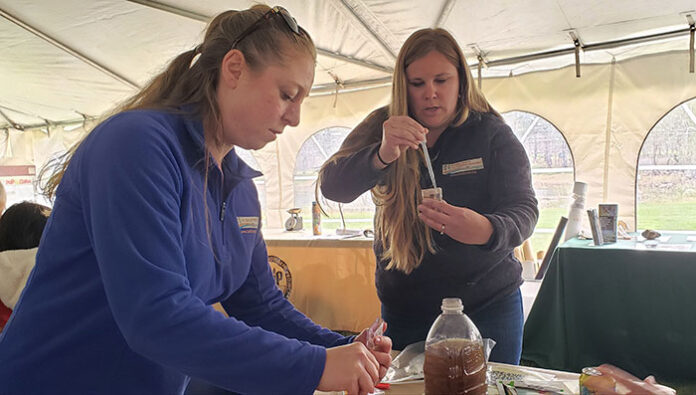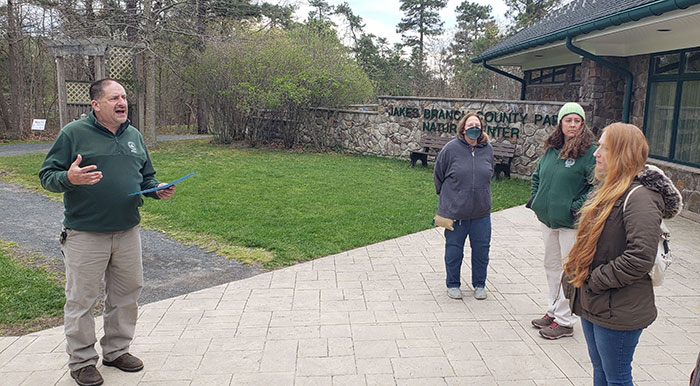
BEACHWOOD – Educators, naturalists and activists came together to learn, share ideas, swap stories and brainstorm during the 25th Annual Barnegat Bay Environmental Educators Roundtable.
The six-hour professional development event was held this year at Jakes Branch County Park. It featured with the theme of “Our Roots Run Deep. Celebrating 25 Years of Local Connections, Culture and Conservation.”
Workshop topics covered the importance of soil to the health of the area watershed and was open to teachers, educators, homeschool parents and nature enthusiasts. An exhibitors area showcased the many environmental groups in Ocean County and beyond.
Becky Laboy, Education Outreach Specialist for the Ocean County Soil Conservation District, said that after two years of providing virtual roundtables, the organizers were very pleased to bring back an in-person, outdoor event. “It felt a little like a family reunion to come together in a live setting. We felt an outside setting would work best.”
Other agencies that were event partners included the Brick Township Municipal Utilities Authority, Save Barnegat Bay and the Board of Ocean County Commissioners.
Area educators explored the important role soil plays in connection to the health of the watershed. Attendees also engaged in a variety of one hour and two-hour field trips and interactive workshops designed to inspire a new appreciation of soil, native woodlands, natural resources, plants, wildlife, local history, and the Barnegat Bay watershed.

Erinn Byers, a second-grade teacher of Cedar Creek Elementary School in Lacey enjoyed the afternoon’s activities and took part in the soil sampling workshop conducted by Ocean County Soil Conservation District Staff members Jessica Pinto and Kristin Adams.
“This is probably my 14th year (attending the forum). You could get an entire curriculum here and I have. I have gotten a curriculum called Wet and it covers marshlands and really the entire surrounding eco system where we reside,” Byers said. “I got another one called Wild which covered all the animals that live in our area. We’ve done an outreach program one year where I had when Becky Laboy came and we had a soil and sediment inspection.”
Pinto and Adams were testing soil texture and the amount of phosphorus in the ground as part of their workshop. “You can take your kids outside and if you have a garden on the ground that is a great place to start and do a soil test,” Pinto said.
While the first activity of the workshop involved a chemistry test, the second involved spritzing water on soil and rolling it up into a ball to literally get the feel of soil texture. Adams remarked “the kids will get their hands dirty, literally” and would be an activity they could enjoy and learn from.
Staff of the Ocean County Parks and Recreation exploring the history of Cedar Bridge Tavern, highlighting archeological findings that helped to paint a clear picture of its rumored and colorful history.
Some attendees went to Double Trouble State Park to peer through the “Window to Pinelands History, Culture & Ecology Guides” with Andrew Anderson of the New Jersey Division of Parks & Forestry and Chris Claus of the Ocean County Parks & Recreation Department.

Over at the Cloverdale Farm County Park, attendees learned about macroinvertebrates of freshwater wetlands from guide hosts Patti Trasferini of the Ocean County Parks & Recreation Department. This program introduced teachers to freshwater macroinvertebrates, which are organisms that have no backbone (invertebrate) that live underwater in freshwater streams, rivers, ponds, and lakes.
Those who went to the workshop at Cattus Island County Park in Toms River learned about Ecology of a Salt Marsh from guides Nikki Vernachio and Megan Zorns, both from Ocean County Parks & Recreation.
They noted that the salt marsh is one of the most unique and important habitats in the Barnegat Bay Estuary. Those who took the tour by van were able to witness the effects of sea level rise on the marsh and the surrounding maritime forest
Among the one-hour tours was the Fire in the Pines program provided by guide Ben Ackerman of Ocean County Parks & Recreation which asked the question, “Only you can prevent forest fires,” but do we really want to?

Ackerman noted that “while we view fire as destructive and dangerous, its absence from the Pine Barrens can cause degradation and damage to a once healthy ecosystem. This includes its relationship with soil, which it both has an effect on and is affected by.”
The Gateway to the Pines tour within Jakes Branch Nature Center and Grounds featured Michele Urban of Ocean County Parks & Recreation who offered educators a sampling of what Jakes Branch County Park could provide to their students.
Urban provided a snapshot of typical Pinelands habitats, saying it is a great place to further explore topics such as soils, watersheds, fire ecology, wildflowers, reptiles, amphibians, history and culture. Educators came away with a variety of field trip/activity choices they can take advantage of with their students.

Ocean County Parks and Recreation staffer German Geogieff led the tour on Cultivating Connections: Soil and Plants Guide where he explained that “the Pine Barrens acquired its name from early potential farmers who found the sandy, acidic and nutrient-poor soil unsuitable for traditional agriculture – declaring it barren.”
Georgieff identified and discussed the native vegetation that has adapted to these unique conditions, some of which are known only to the Garden State.
While the ground surface was the subject of most programs of the day, the Astronomical Society of the Toms River Area (ASTRA) brought along their telescopes for those interested in astronomy and space sciences for those with interests a bit higher than the ground surface.







